Menu
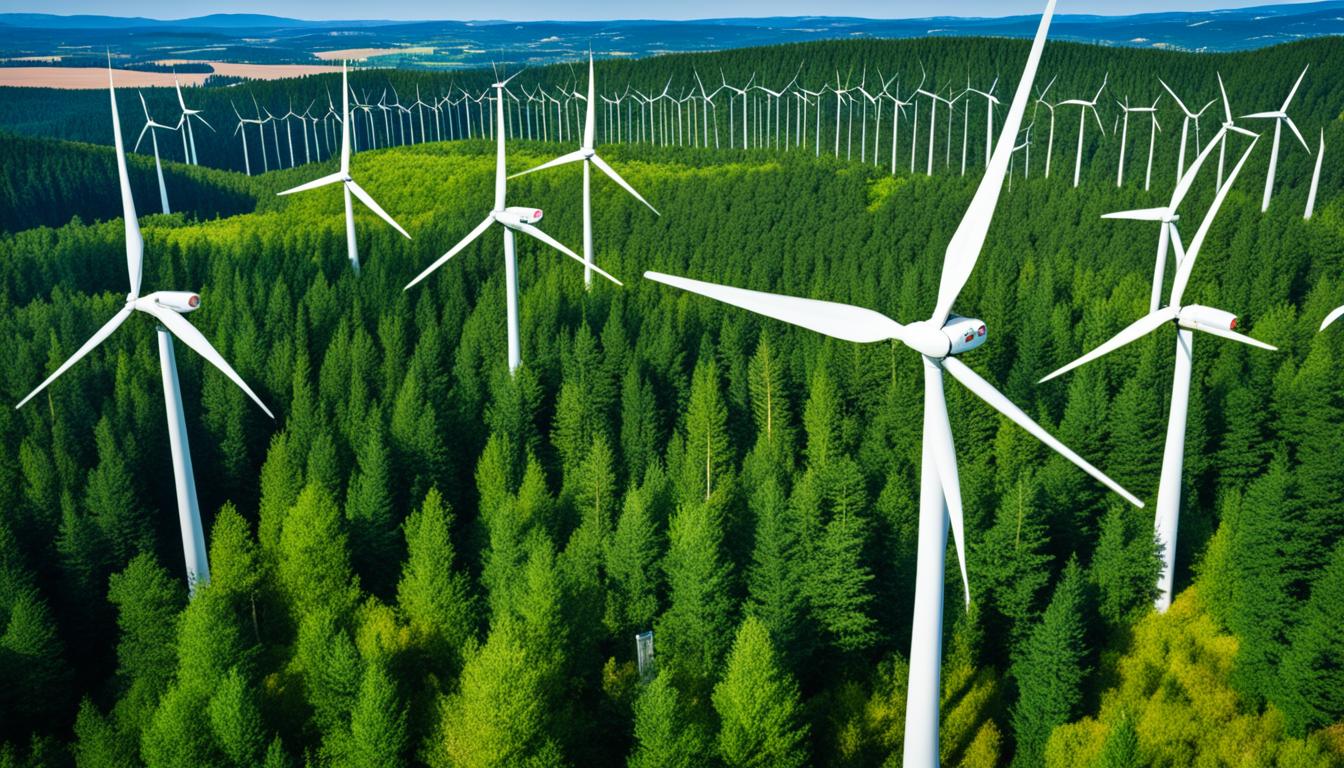
By 2030, the EU wants to plant 3 billion trees. This is part of the big European Green Deal. It aims to have no net greenhouse gas emissions by 2050. To get there, the European Commission wants to cut emissions by 55% compared to 1990 by 2030. This is a major step towards sustainability. It’s supported by €1.8 trillion from the NextGenerationEU Recovery Plan and the EU’s budget for seven years. The goal is to make the EU a modern, eco-friendly, and competitive place.
The EU Green Deal puts in place several important rules. These rules are about being green and fighting climate change. The aim is to have a continent that doesn’t hurt the planet but still grows well. The laws focus on making less pollution, using more renewable energy, and using energy smarter. It’s all about making a green and fair future for everyone.
The EU Green Deal started in December 2019. It’s a big step to fight climate change and to be more green in the European Union. The goal is to have no net greenhouse gas emissions by 2050. This plan aims to make changes in energy, transport, and farming. It’s a big step towards a greener, more sustainable future.
The EU Green Deal began because we realised we have to do something about our planet. It aims to cut down on greenhouse gases by 55% by 2030. These goals include using our resources better, making sure everyone is included, and policies that help the planet. A third of the €1.8 trillion from a special Recovery Plan will help pay for these changes.
The world’s environment is changing fast, and we need to act quickly. The EU is leading the charge to be more sustainable. It’s making sure funds are there to be smarter about climate, energy, and transport. For example, a plan to stop using Russian fossil fuels is in place. Plus, we aim to plant 3 billion trees and greatly increase wind power at sea by 2050.
Overall, the EU Green Deal is a big, united effort to make our planet greener and stronger for the future. It brings a lot of people and money together for this important cause.
In 2023, steps were recommended to meet the carbon neutrality goal. Deciding on lowering greenhouse gas emissions is on the right path. But, we’re not moving fast enough. Areas like buildings and transport need to do more.
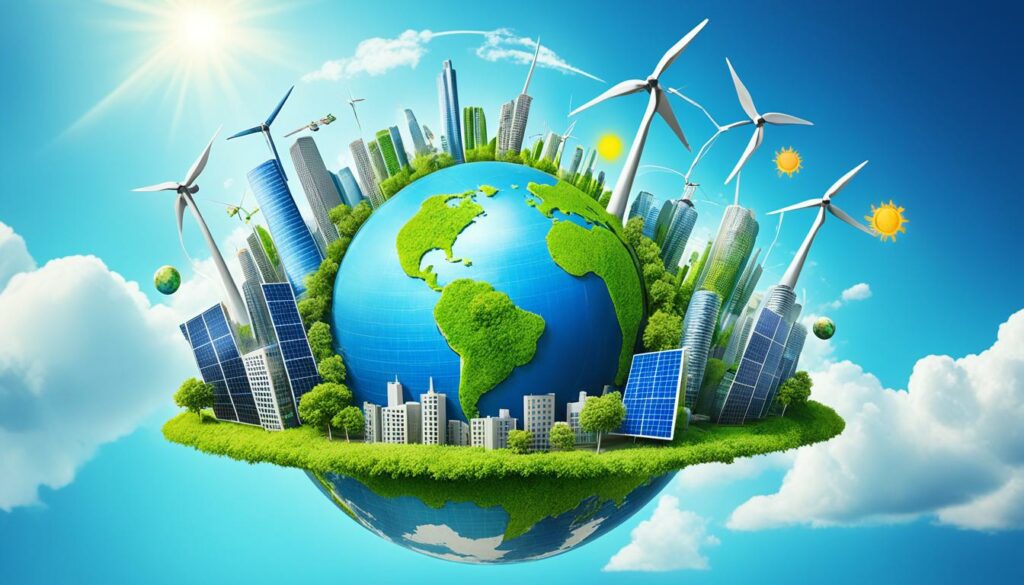
Farming still faces big challenges. The amount of land and forests that absorb carbon is reducing. The way the EU’s plan is applied varies. Countries need to work harder. They should focus on managing risks and protecting nature to meet the EU climate objectives.
The EU wants to reach climate-neutrality by 2050. This means having no net greenhouse gas emissions. Countries sent in their long-term plans by January 2020. They align with their Energy and Climate Plans for 2021-2030. These strategies must be updated every five years, with the next due in 2029, and then every ten years after.
Projects are underway to bring finance into the fight against climate change. They support clean energy for islands and invest in green industry. Studies look at how we can cut emissions deeply. They consider new tech, scenario planning, and changes in how we act.
For us to grow economically without harming the planet, we have to act now. All sectors must step up to meet the EU’s climate goals. The main target is for Europe to have no climate impact by 2050. This will come from cutting emissions a lot, using strong policies and new ideas.
The EU Green Deal is a big set of laws. It’s meant to make Europe more green and fight climate change. These laws set tough goals. They want to cut how much greenhouse gases we make and push for recycling more. The European Commission is leading the way with plans like the Fit for 55, the Circular Economy Action Plan, and the Batteries Regulation.
The Fit for 55 package is very important. It was started in July 2021. It aims to cut net greenhouse gases by 55% by 2030, compared to 1990. The Circular Economy Action Plan is about using resources in a better way. It wants to make sure things get reused more. Plus, it wants more things to be made with materials that don’t harm the planet. The Batteries Regulation is working to make batteries less bad for the Earth.
How these laws affect countries is quite big. For instance, by 2035, all new cars sold in Europe must not pollute the air. This rule pushes countries to change how they make cars. Every nation needs to cut the air pollution each person makes by 25%. To hit the EU Green Deal goals, countries must keep adjusting their laws and how they do business. This change will need lots of money, maybe around €1 trillion by 2030.
Below is a detailed comparison of key targets and regulations under the EU Green Deal:
| Key Regulation | Target | Impact |
|---|---|---|
| Fit for 55 | 55% reduction in GHG emissions by 2030 compared to 1990 | Zero-emission vehicles by 2035 |
| Circular Economy Action Plan | Promote sustainable consumption | Encourages recyclable and renewable materials |
| Batteries Regulation | Eco-friendly battery production and recycling | Enhances sustainability of battery lifecycle |
The EU Green Deal is a big challenge. It requires all countries to follow strict laws. This big effort is for a sustainable future, one that’s good for the planet and people.
The Fit for 55 package is the EU’s big move towards reaching tough sustainability targets. It wants to cut greenhouse gas emissions by 55% before 2030, compared to 1990. This effort will spread across many areas in our society. It tries to deal with the threats of climate change head-on.
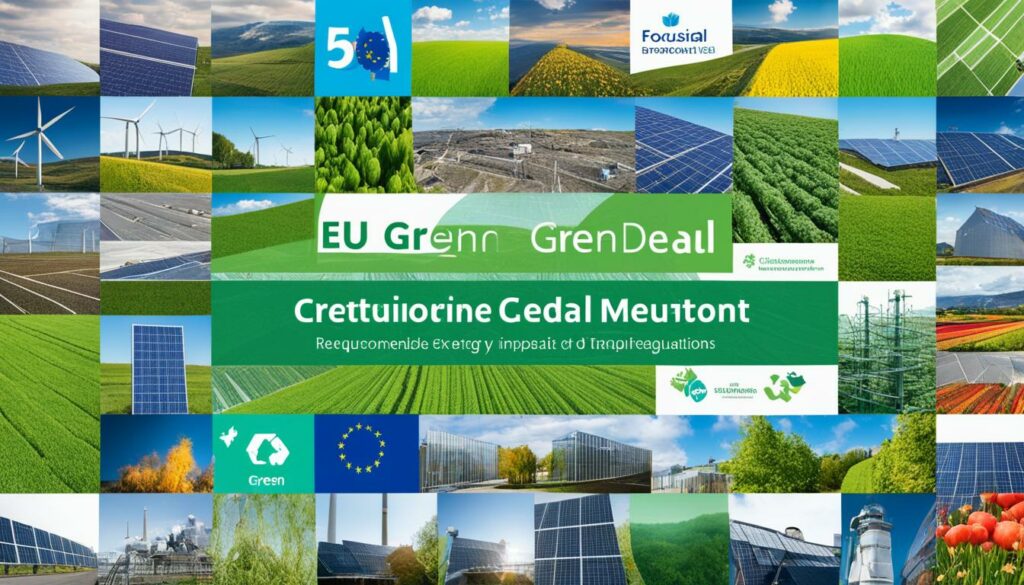
The key aim of the Fit for 55 package details is to unite all EU countries in this challenge. They have several important goals to hit:
The package includes many laws to make businesses cleaner and greener. For example, it will change the rules on getting energy from renewable sources. This will help more clean energy come into use. It also aims to make companies use energy more efficiently.
The plan also wants to change how we tax energy to encourage using less. And it aims to make imports play fair on the environmental front. This will make sure our companies keep up without harming the planet.
Starting from 2027, the plan will make sure companies pay for the pollution they create. This will push them to cut back on harmful emissions. The end goal is to have no net emissions by 2050. It’s a big step towards that.
There’s a big pot of money to help those who might struggle with these changes. The EU is putting in €65 billion to support this effort. This money will help the less fortunate and smaller companies go green. Combined with an increase in using renewable resources, the EU is showing it is truly serious about its green promises.
| Target | Goal |
|---|---|
| Greenhouse Gas Emission Reduction | 55% by 2030 |
| Renewable Energy Share | 42.5%-45% by 2030 |
| Energy Efficiency Improvement | 11.7% by 2030 |
| Investment in Climate and Energy Projects | 100% of Emissions Trading Revenues |
| Support from Social Climate Fund | €65 billion from EU Budget |
Energy efficiency upgrades play a key role in the EU Green Deal. They aim to cut down on carbon emissions. This is done by improving buildings and using more renewable energy.
About 36% of the EU’s greenhouse gases come from buildings. Making them more efficient is vital for reaching our climate goals.
The EU wants to cut down on how much energy buildings use. They have set a goal to reduce energy use by 11.7% by 2030. Every year, countries must save at least 1.49% more energy.
Big buildings that use more than 85 TJ of energy every year must manage their energy use. They must also get audits to make sure they follow the rules. Companies using over 10 TJ need to check their energy use and make a plan to save more.
Now, large data centres must report their energy performance. They also need to keep track of their progress. The EU is making rules stricter about how heating and cooling services must be more eco-friendly by 2050.
The EU is also offering new certifications for people who work in energy efficiency. This helps improve how we save energy. It also encourages new ways to pay for these changes.
The EU is working hard to use more renewable energy. This includes looking closely at how companies use energy. They want to make sure businesses are getting more energy-efficient every year.
The EU is also focused on helping those who struggle to pay for energy. They want to make sure everyone can live in homes that use energy wisely. By improving how big cities provide heating and cooling, they hope to use energy smarter.
There’s a new EU database that shows how well data centres use energy and water. This shows how the EU is being open about its efforts to save energy.
| Key Initiative | Description | Target |
|---|---|---|
| Final Energy Consumption Reduction | Legally binding reduction by 2030 | 11.7% compared to 2020 |
| Annual Energy Savings Obligation | EU countries’ obligation from 2024 to 2030 | 1.49% annually |
| Public Sector Reduction | Annual energy consumption reduction target | 1.9% annually |
| Energy Management Systems | For large energy consumers >85 TJ | Mandatory |
| Energy Audits | Required for enterprises >10 TJ | Compulsory action plan |
The EU’s Circular Economy Action Plan (CEAP) was made in 2015. It includes 54 actions. These actions aim to change Europe’s economy from a linear to a circular model. This makes consumption more sustainable by using fewer resources and reusing materials.

The CEAP focuses on managing waste better. It aims to reduce landfill use and increase reuse and recycling by 2030 and 2035. Over EUR 10 billion in public money was put towards this from 2016 to 2020. By 2019, all 54 actions were in place, showing the plan works.
The CEAP has also helped create more jobs in the EU. Jobs in the circular economy grew by 6% from 2012 to 2016. Since 2015, the EU has been a top global influencer in the circular economy. This plan inspired many places in Europe to make their own strategies for a circular economy.
The success of the CEAP is thanks to teamwork. Both Industry/Enterprise and Environment Directorates-General lead it. They work with many others to make sure circular economy plans are followed well.
The CEAP recognises we must use Earth’s resources more wisely. Without change, we will need three Earths’ resources by 2050. Handling waste like e-waste better is key, as much of it goes unrecycled. The plan also urges for better packaging and the shift to eco-friendly plastics.
Challenges in sectors like textiles highlight the need for change. The plan also works on reducing microplastics and cutting food waste by half by 2030. These efforts aim to make various industries more sustainable.
The CEAP targets important areas like plastics and food. It also focuses on sectors like textiles and e-waste. Its goal is a complete shift to a circular economy. This supports the EU’s bigger goal for a sustainable future.
The EU Green Deal focuses a lot on sustainable farming. It’s key for a strong, eco-friendly food system. This move aims to use fewer chemicals. It also wants to grow organic farming. These steps fit into the EU’s bigger plans for greener agriculture.
The Farm to Fork Strategy is crucial for eco-friendly food systems. By 2030, it wants to cut chemicals like pesticides. This includes using less harmful pesticides too. To make farming in the EU more sustainable, big changes are needed. For example, they plan to lose fewer nutrients in farming. They also want to keep the soil healthy and use less fertiliser. Aiming for these cuts in chemicals and additives will help the environment.
The Organic Action Plan works alongside the Farm to Fork Strategy. It aims for a big growth in organic farming. The target is to put at least 25% of EU’s farm land under organic methods by 2030. They also want to grow organic aquaculture a lot. This plan has strong rules for earth-friendly farming. It wants to boost soil health, keep various plants and animals safe, and cut down antimicrobial use by half in certain farming.
The EU Green Deal pledges to make our surroundings toxic-free. Its goals include reducing air, water, and soil pollution by 2050. To achieve this vision, new rules, better science, and health schemes will all play a part. This is to make sure our environment is green, clean, and safe.

The plan looks to make the air cleaner across the EU. Its aim is to lower air pollution, cutting early deaths by 55%. Achieving this will involve a big push to cut CO2 from transport by a quarter. Plus, a 30% cut in noise from traffic is on the cards.
Focus is also on purifying water and restraining soil pollution. Targets included are cutting sea plastic by half and lowering microplastics by 30%. Steps to reduce nutrient loss and pesticide use by half are part of the soil mission. This should make the land healthier. Protecting a quarter of the EU’s at-risk ecosystems is also vital.
By setting firm goals, the EU aims to create a clean, healthy area for its people. It’s working hard on many fronts like air, water, and soil. The Green Deal is a big part of this push for a better future for all.
The EU Green Deal is a big step towards saving our biodiversity and securing our ecosystems. It has set strong goals for our land and sea areas. The strategy is all about looking after and bringing back nature’s homes.
The EU is focusing on its forests a lot. Its new strategy aims for more trees and better care for the ones we have. These efforts are key to trapping carbon and keeping our planet healthy. Adding more trees and taking good care of them will help us meet our forest goals. It will also help keep a variety of plants and creatures safe. This plan points out the importance of cutting down on forest fires. It also says we need more trees to soak up CO2. These steps are essential in fighting climate change.
Along with land, the EU is pushing hard to protect our seas. It’s working to create more safe areas in the ocean. These places will help protect fragile sea homes and the many species living there. These efforts are part of a bigger plan to heal our ecosystems. They tackle problems like too much fishing, pollution, and loss of homes for sea life.
This strategy doesn’t just cover the land. It also makes promises for the sea. By 2030, the plan is to fix and protect both types of ecosystems. A new law is proposed to make sure these promises are kept. This big change is key to saving our diverse plants and animals. It shows the EU is leading in keeping our planet healthy.
| Strategy Component | Key Actions |
|---|---|
| Forest Strategy | Afforestation, forest preservation, CO2 absorption enhancement |
| Marine Conservation | Expansion of marine protected areas, pollution control, habitat protection |
The EU Green Deal wants nature to be part of our daily lives. It works with other plans like the European Green Deal and Farm to Fork Strategy. This shows how important it is to take care of nature for a safe future.
The EU Green Deal aims to cut transport emissions by 90% before 2050. It’s a big task needing lots of money for electric vehicles and better public transport. It hopes to change how we move around Europe for the better.
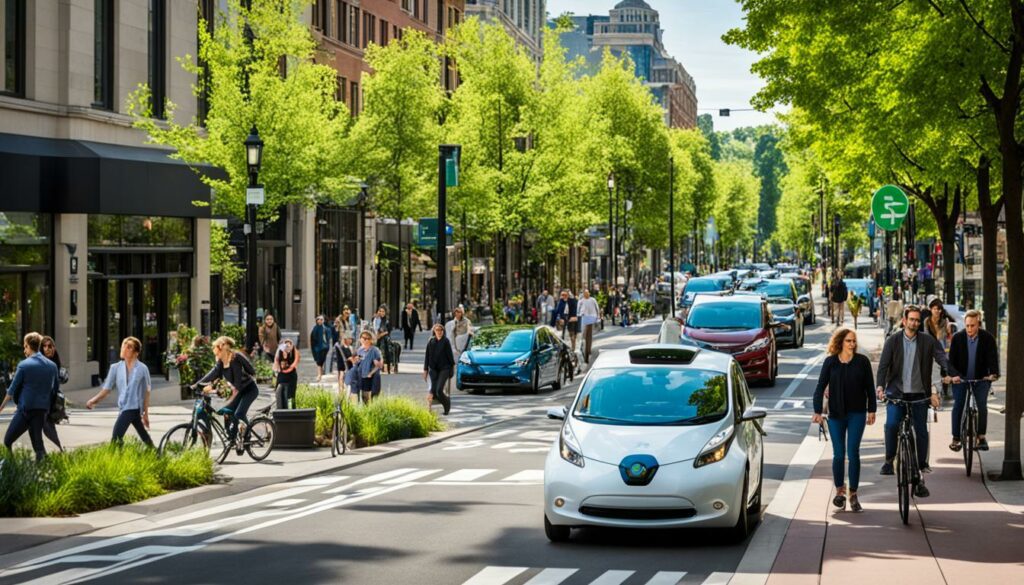
Easing into electric vehicles is key for the EU. These include cars, vans, trucks, and buses polluting more than 70% of the transport sector’s greenhouses gases. The ‘Fit for 55’ plan wants a 55% drop in CO2 for cars and a 50% cut for vans by 2030. It also pushes for no more emissions by vehicles come 2035. This effort relies on the EU’s Regulation (EU) 2019/631, which forces vehicle makers to come up with ways to meet these lower CO2 goals.
Overhauling public transport is as big as focusing on electric cars. The EU wants to see more people using trains and boats for trips between cities. It aims for these means to cover half of those journeys. This change is vital since public transport uses 31.7% of Europe’s energy. Upgrading it will help ease traffic, lower emissions, and offer better choices than cars that burn fuel.
Transport is a major source of the EU’s climate pollution. Efforts like investing in electric cars and making public transport better are crucial. They show the EU’s strong push for a cleaner future for all.
| Key Goals by 2050 | Strategies |
|---|---|
| 90% Reduction in Transport Emissions | Electric vehicle investment, modernising public transport system |
| At least 30 Million Zero-emission Cars | Incentives for electric vehicle manufacturing and purchasing |
| 50% Shift From Road to Rail & Waterborne Transport | Sustainability in mobility through better infrastructure |
Having strong financial plans is key to making the European Green Deal work. The Green Deal financing shows how important investing in green projects is. It outlines the need for sustainable spending to create a better future.
The NextGenerationEU plan is vital for Europe’s financial future. It deals with getting over COVID-19 and pushing for green goals. The aim is to put at least €1 trillion into good use over ten years. About 30% of the budget from 2021 to 2028 will go to green efforts.
Each EU country must spend 37% of their share from the Recovery Plan on eco-friendly projects, which is a big €672.5 billion total. The EU also plans to get 30% of its funds by selling green bonds. This will keep the money flowing into important green projects.
Money for climate projects is top priority in the EU’s budget too. The Green Deal Plan wants to move lots of money from 2021 to 2027 for green growth. This helps areas most affected by the shift to a green economy. For development, 30% of funds must help the Green Deal. Also, 37% goes to reach zero carbon by 2050.
The InvestEU plan aims to put 30% of its funds into climate help. It mixes private and public money to be smarter with funds. The EU also wants to clearly define what counts as green. This would get more businesses interested in funding eco-friendly projects. All this shows the EU’s serious about cutting down on gases that harm our planet by 55% by 2030, like they said in their plans.
| Investment Measure | Percentage Allocation | Financial Instrument |
|---|---|---|
| NextGenerationEU Green Investments | 30% | Multiannual Budget & Recovery Fund |
| Recovery and Resilience Facility (Climate) | 37% | €672.5 billion |
| EU Regional Development Fund (Green Deal) | 30% | Cohesion Policy |
| Cohesion Fund (Climate Neutrality) | 37% | Climate Projects |
| InvestEU Programme (Climate Objectives) | 30% | Private and Public Funds |
The EU Green Deal aims to change the industrial strategy. It wants to create a green economy through specific actions and laws. This shift is crucial for encouraging eco-friendly manufacturing in many sectors.
The EU has big plans for making production cleaner. Essential to this is helping businesses that want to go green. Through the Green Deal Industrial Plan, these companies may get tax benefits for making products with no emissions.
Programs like the Recovery and Resilience Facility and REPowerEU make it easier to start projects. They also offer tax breaks and help improve the industry’s skills. These steps are key for companies moving towards zero emissions.

There are strict laws promoting eco-friendliness within manufacturing. They make it easier to support clean energy and reduce pollution. For example, the Net-Zero Industry Act sets big emission reduction goals for 2030.
It says that 40% of the EU’s advanced green tech must come from its own manufacturing. Programs like InvestEU and the Innovation Fund show the EU values green innovation. Easing rules on state aid for clean tech could help businesses even more.
| Initiative | Funding/Policy | Objective |
|---|---|---|
| Inflation Reduction Act (IRA) | $369 billion USD | Climate measures including tax breaks for low-carbon energy |
| EU Green Deal Industrial Plan | N/A | Support green manufacturing and simplify investment processes |
| CHIPS and Science Act | Over $70 billion USD | Dedication to climate spending initiatives |
| InvestEU Program | N/A | Simplify funding for climate challenges |
| Innovation Fund | N/A | Support renewable hydrogen production launching in autumn 2023 |
Climate risk mitigation is now more important than ever. With fewer greenhouse gases, the EU is leading in protective climate policies. Yet, work is uneven among different areas, despite the progress under the EU Adaptation Strategy.
The farming sector is slow to lower emissions. And, we’re losing our ability to absorb carbon in the earth. Countries need to do more about rules, money, and planning. They should use more nature-based solutions to get better at handling crisis situations.
The European Climate Law guides countries on how to update their energy and climate plans. This helps make environmental risk forecasting better. The EU aims to stop all harmful gas emissions by 2050. It also plans to cut these emissions by 55% by 2030.
A lot of money is being invested in green projects. Part of the €1.8 trillion is from the NextGenerationEU Recovery Plan. This shows the EU is serious about saving the planet. It’s not just about making new rules; it’s also about big money investments in our future.
Innovation is key on the path to meeting the EU Green Deal’s big aims. It drives changes that are good for the planet in many areas. By using research, the EU can take on the complex problems caused by climate change.
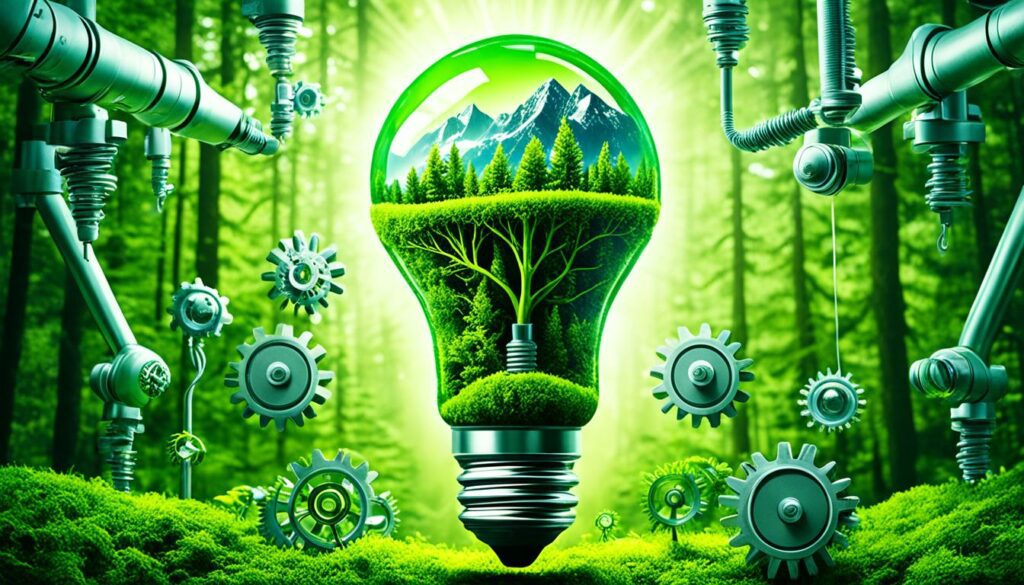
Green Deal projects get a lot of support thanks to Horizon Europe. More than a third of its spending focuses on fighting climate change. This shows how important it is to invest in greener technology.
The European Commission put a huge amount of money into these efforts. They work with others on projects like clean transport and making steel with fewer emissions. Together, they’re looking for the best ways to make a real difference.
Around €1 billion was set aside for the Green Deal through Horizon 2020. This shows a major push to fight climate change and save nature. 73 projects got the green light, aiming at finding new tech and eco-friendly ways of doing things.
| Category | Details |
|---|---|
| Funding (€) | 1 Billion |
| Projects Selected | 73 |
| Horizon Europe Budget Contribution (%) | 35% |
| Mission Areas Supporting Green Deal | 4 out of 5 |
It’s estimated that Horizon Europe will add about €35 billion more. This is part of over €1 trillion meant to push the Green Deal forward. The investment is focused on achieving big changes by 2030.
Researchers applying for Horizon Europe funds must meet certain green standards. This is to ensure their work does not harm the planet. They must follow the Taxonomy Regulation to meet these standards.
Guidance with information on how to help and not harm the environment is available. It’s very detailed, covering many industries. The Joint Research Centre looks into projects, which may include nuclear power, to make sure they are safe for the environment.
This process is not without debate, especially about nuclear power’s effects. But, the aim to do research that helps our planet is strong, facing all challenges.
The EU Green Deal is a big plan for making Europe greener. It covers a lot of areas like fighting climate change, using more renewable energy, and creating less waste. The aim is to make Europe carbon neutral by 2050.
One of its main goals is to cut greenhouse gas emissions by 55% by 2030. This will help reach the bigger goal of not contributing to climate change by 2050. Despite these big aims, experts say more needs to be done. The EU needs more money, about €2.5 trillion, to really go green.
Using money wisely and picking eco-friendly ways to do business is crucial. Areas like making power, moving around, making things, and farming need to change. This change will take a lot of money, like the €1 trillion the EU says we need. This shift is key to making the EU Green Deal work.
In the end, the EU Green Deal is a full vision of a sustainable future. It lays down what needs to happen and how much it will cost. Everyone, from countries to businesses to people, must pull together. Only then can we achieve the big dreams of the EU Green Deal.
The EU Green Deal aims to make the European Union climate-neutral by 2050. It plans to do this by cutting down greenhouse gas emissions and promoting a sustainable economy. This will help the environment and make Europe a better place for everyone.
The main goals include becoming carbon neutral by 2050 and cutting emissions by at least 55% by 2030. It also wants to grow the economy without using too many resources. Energy systems will change, and we’ll recycle more to make Europe stronger against climate change.
The EU is providing €1.8 trillion from the NextGenerationEU Recovery Plan and its budget over seven years. This money will help with many projects under the Green Deal. It shows a big commitment towards a greener future.
The important rules include the Fit for 55 package, the Batteries Regulation, and the Circular Economy Action Plan. These laws cover areas like climate, energy, transport, and taxes. They make sure Europe reaches its green goals.
The EU will work on many fronts to become carbon neutral. It will use less energy, more renewable energy, and recycle more. A new climate law makes sure businesses and governments work hard to meet these goals.
The Fit for 55 package wants to cut emissions by 55% by 2030. It brings new rules for cleaner energy, better transport, and more taxes on polluting products. These changes are key to tackling climate change.
More focus will be on making buildings use less energy and release fewer emissions. We’ll aim for better energy ratings for buildings. Using more clean energy is a big part of these plans.
The Circular Economy Action Plan encourages using resources longer. It wants to design products that can be used again or turned into something else. This way, less harm is done to the environment.
The Farm to Fork Strategy wants to make our food system fair and green. The Organic Action Plan is about growing food in a way that’s good for the land. Both plans aim for a healthier environment by 2030.
The Zero Pollution Ambition aims to make air, water, and soil safe by 2050. The goal is to improve air quality and keep water clean. We also want to protect the soil and wildlife against harmful man-made chemicals.
The EU plans to plant more trees and protect forests. It also focuses on keeping the oceans clean. With these efforts, the EU hopes to bring back more wildlife and plants.
The EU aims for a 90% drop in how much pollution we make from transport by 2050. To do this, we will use more electric cars, make public transport better, and choose smarter ways to move around.
The EU plans to spend €1.8 trillion on the Green Deal over the next seven years. This money is from the NextGenerationEU fund and the EU budget. It will help pay for many green projects and support our goals.
The EU wants industries to make things in a more earth-friendly way. Laws will encourage greener practices and help new green ideas to grow. These steps are vital for a cleaner industry future.
The EU is setting up stronger plans and rules to protect against climate problems. We will work to predict and prevent risks to keep our world stable.
Science and new ideas are key to the Green Deal’s success. They focus on creating technologies and ways of living that help the environment. The EU supports this research to make our green dreams come true.